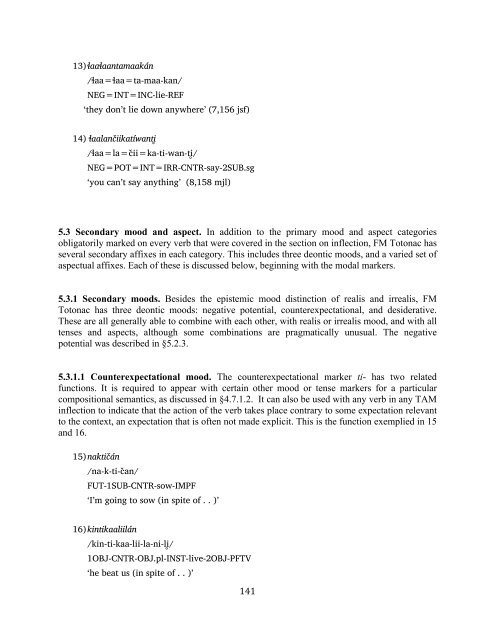The phonology and morphology of Filomeno Mata Totonac
The phonology and morphology of Filomeno Mata Totonac
The phonology and morphology of Filomeno Mata Totonac
You also want an ePaper? Increase the reach of your titles
YUMPU automatically turns print PDFs into web optimized ePapers that Google loves.
13) "aa"aantamaakán<br />
/#aa=#aa=ta-maa-kan/<br />
NEG=INT=INC-lie-REF<br />
‘they don’t lie down anywhere’ (7,156 jsf)<br />
14) "aalanc%iikatíwanti&<br />
/#aa=la=c"ii=ka-ti-wan-ti&/<br />
NEG=POT=INT=IRR-CNTR-say-2SUB.sg<br />
‘you can’t say anything’ (8,158 mjl)<br />
5.3 Secondary mood <strong>and</strong> aspect. In addition to the primary mood <strong>and</strong> aspect categories<br />
obligatorily marked on every verb that were covered in the section on inflection, FM <strong>Totonac</strong> has<br />
several secondary affixes in each category. This includes three deontic moods, <strong>and</strong> a varied set <strong>of</strong><br />
aspectual affixes. Each <strong>of</strong> these is discussed below, beginning with the modal markers.<br />
5.3.1 Secondary moods. Besides the epistemic mood distinction <strong>of</strong> realis <strong>and</strong> irrealis, FM<br />
<strong>Totonac</strong> has three deontic moods: negative potential, counterexpectational, <strong>and</strong> desiderative.<br />
<strong>The</strong>se are all generally able to combine with each other, with realis or irrealis mood, <strong>and</strong> with all<br />
tenses <strong>and</strong> aspects, although some combinations are pragmatically unusual. <strong>The</strong> negative<br />
potential was described in §5.2.3.<br />
5.3.1.1 Counterexpectational mood. <strong>The</strong> counterexpectational marker ti- has two related<br />
functions. It is required to appear with certain other mood or tense markers for a particular<br />
compositional semantics, as discussed in §4.7.1.2. It can also be used with any verb in any TAM<br />
inflection to indicate that the action <strong>of</strong> the verb takes place contrary to some expectation relevant<br />
to the context, an expectation that is <strong>of</strong>ten not made explicit. This is the function exemplied in 15<br />
<strong>and</strong> 16.<br />
15) naktic%án<br />
/na-k-ti-c"an/<br />
FUT-1SUB-CNTR-sow-IMPF<br />
‘I’m going to sow (in spite <strong>of</strong> . . )’<br />
16) kintikaaliilán<br />
/kin-ti-kaa-lii-la-ni-li&/<br />
1OBJ-CNTR-OBJ.pl-INST-live-2OBJ-PFTV<br />
‘he beat us (in spite <strong>of</strong> . . )’<br />
! "("!

















